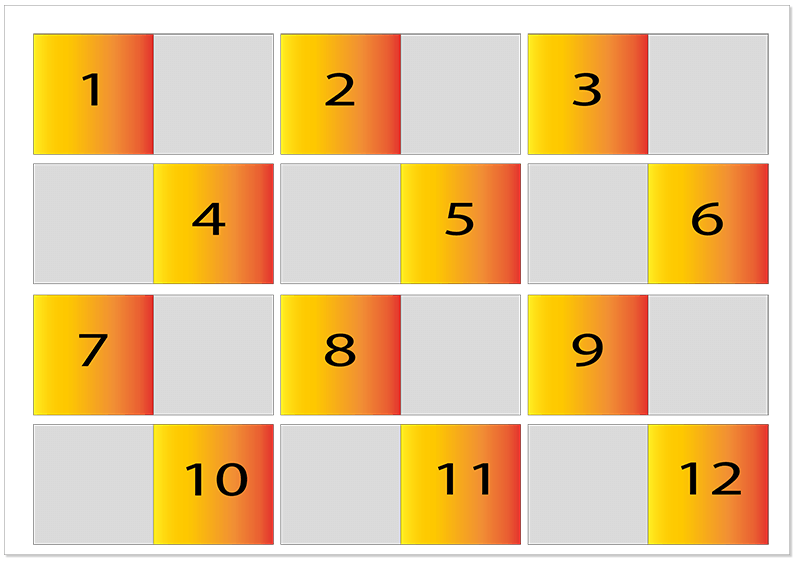In this article we’ll discuss the factors that can affect what card sizes you choose. The size of your cards is not just a design consideration, it can have a significant impact on your costs (and thus margins) too.
- Introduction
- Card Sizes: things to consider – you are here
- Image Resolution
- Understanding Colour modes (CMYK vs RGB vs Pantone)
- Bleed and Trim
- Finishing Layers (Foil, flitter, emboss)
- Getting Files Press Ready Checklist
- Working with your Printer
Shapes & Sizes
Look down the racks of you local card shop and you’ll see cards in all shapes and sizes – square, rectangle, tall & thin, short and fat, small, large, and even intricate cut out shapes. While it may look like there’s as many sizes as there are publishers, a closer look will reveal that there’s actually a lot of overlap in card sizes – there’s probably only a couple of dozen or so sizes covering 80% of the market.
Aside from your design, there are two main factors you need to consider when deciding on a card size:
- How many cards fit on to a sheet when printing
- The envelope size
Let’s take a look at each of these in turn.
Cards on a sheet
Paper sizes are standardized – A3, A4, A5, etc are sizes you’re probably already familiar with (the “A” series of paper sizes). Commercial printers predominantly use the B-series of sheet sizes. Typically printers will use B1 and/or B2 as their in-house standard sheet size.
| Format | Size |
|---|---|
| B1 | 707mm x 1000mm |
| B2 | 505mm x 707mm |
When commercial printers, price up a print job, the the factors that will affect the price will be the colours, finishes, which board you use – but the size of your cards is not as important a factor as you might think at first. That’s because the process of printing a sheet is the same whether you have 10 or 20 cards on the sheet – the machines don’t do anything different based on what’s actually being printed. Sure, the number of cards can affect the price of the sheet setup, and the finish dies (like foil dies for example), but the bulk of the cost is in the printing.
For this reason you’ll want to maximise the space used on the sheet. A small change to the size of your cards can affect how many cards you print on a sheet – a few mm change in card size could mean an extra card on the sheet, and a significant reduction in the cost per card.
You don’t need to re-invent the wheel here. Your printers will be able to tell you how many cards of a particular size will fit on a sheet, and how you can maximise the number of cards you print.
Envelope Size
The second factor to take into account when deciding on your card size is the size of the envelope. While you’re free to choose any card size, you’ll increase your costs significantly if you have to have your envelopes especially made for a bespoke size.
For new publishers just starting out, it’s far more cost effective to choose a standard envelope size and choose your card size accordingly. Envelopes are largely commoditized and benefit from economies of scale, i.e. the larger the quantity manufactured, the cheaper they are per unit. Envelope Manufacturers therefore usually have the standard card sizes in stock most of the time. By choosing a standard size, you’ll benefit from lower prices per envelope than having to pay for a whole manufacture run of a bespoke size.
That’s not to say you have to conform to the norm. You can have bespoke sizes or designs of envelopes made, provided you require significant enough quantities to make it cost effective.
Even if you want an envelope with a specific design, it’s worth asking for it to be made to a size for which the envelope supplier already has the “tooling” (i.e. the cutting template) for that size.
Envelope size vs card size
Your card needs to fit inside the envelope so the envelope needs to be slightly larger than the folded card size. As a rule of thumb, the envelope should be 5mm to 6mm wider taller than the folded card size. For example if choose a 155mm x 155mm envelope, then your card will be 150mm x 150mm when folded (300mm x 150mm flat).
Common Card sizes
Some of the more common card sizes are as follows:
- 100mm x 150mm
- 125mm x 125mm
- 140mm x 140mm
- 127mm x 177mm
- 145mm x 145mm
- 150mm x 150mm
- 120mm x 170mm
- 150mm x 210mm
Shape: Square vs Rectangle
Finally, a quick word on shape. While square cards are very popular in the UK, you should consider the nuances of your target market when deciding on a shape for your card. For example in the USA, it costs more to post a square card than a rectangular card, and for this reason square cards are less popular in the US – something to keep in mind if you’re looking to export across the pond.

